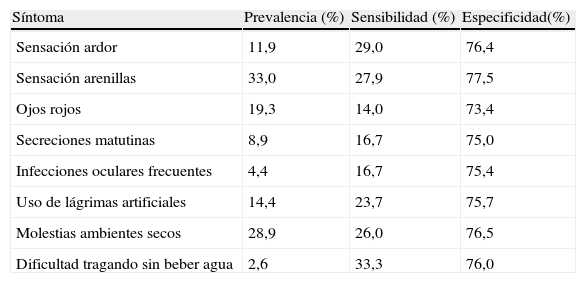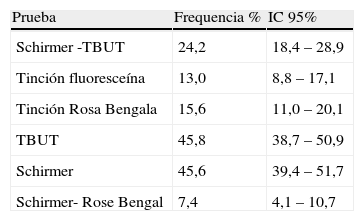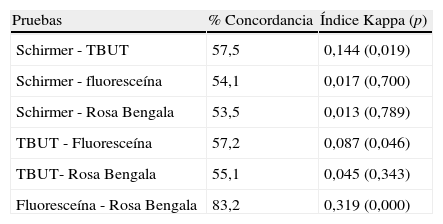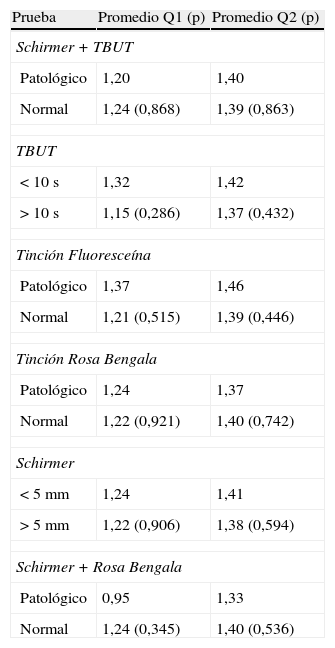Reportar la prevalencia del síndrome de ojo seco (SOS) y calcular la validez interna de dos cuestionarios para diagnosticar el síndrome de ojo seco y correlacionarlo con los resultados de varias pruebas diagnósticas.
Material y métodoSe seleccionaron pacientes mayores de 50 años del sistema de salud de Castilla y León, en Valladolid. Contestaron los cuestionarios modificados de McMonnies (Q1) y Ocular Surface Index questionnaire (OSDI, Q2) y se les realizó: tiempo de ruptura lagrimal (TBUT), tinciones con fluoresceína y rosa de bengala y Schirmer con anestesia. Se registraron los resultados y se realizó análisis descriptivo, de concordancia y fiabilidad de Q1 y Q2 mediante áreas bajo la curva ROC.
ResultadosUn total de 270 sujetos (58,2% mujeres; 41,8% hombres) con edad promedio de 64,5 años (IC 95%: 63,3 - 65,7) se enrolaron. El promedio de Q1 fue de 1,2 y la “sensación de arenillas” y las “molestias en ambientes secos” los síntomas más frecuentes. Para Q2 99,2% fueron “sensación de arenillas” y 98,9% “sensación de ardor”. Con la combinación Schirmer-TBUT, la prevalencia del SOS en Valladolid fue del 24,2%, 45,8% con TBUT y 45,6% con Schirmer. Utilizando Schirmer-TBUT, la prevalencia del SOS fue de 27,6% para mujeres (p<0,15) y 19,6% para hombres. Los valores del área bajo la curva ROC para Q1, Q2 y la mayoría de las pruebas diagnósticas fueron<0,5, excepto para Q2 y TBUT (0,503). Para Schirmer-TBUT, el valor de Q1 fue de 0,49 y 0,45 para Q2. Los valores de Cronbach alfa fue > 0,7 para todos los ítems de Q1 y Q2. Se obtuvieron concordancias estadísticamente significativas (p<0,05) con la combinación Schirmer – TBUT (κ=0,14) y TBUT- tinción fluoresceína (κ=0,09).
ConclusionesQ1 y Q2 no son fiables para el diagnóstico del SOS y tienen pobre consistencia interna. Las tinciones con fluoresceína y rosa de bengala resultaron ser las más concordantes para el diagnóstico del SOS. No hay correlación entre los cuestionarios y las pruebas diagnósticas objetivas del SOS.
To report the prevalence of dry eye syndrome (DES) in a subset of patients > 50 years old in Valladolid, Spain, calculate internal validity of two DES screening questionnaires, and correlate the results with DES diagnostic tests.
MethodsPatients > 50 years-old were randomly selected from the medical network census in Valladolid; they answered the modified McMonnies questionnaire (Q1) and the Ocular Surface Index questionnaire (Q2) and then underwent an ophthalmic evaluation which included: tear break-up time (TBUT), fluorescein and Rose Bengal staining, and Schirmer with anesthesia were performed. Descriptive analysis, test concordance analysis, and Q1 and Q2 reliability using ROC curves were performed.
ResultsA total of 270 subjects (58.2% female; 41.8% male) with an average age of 64.5 years (95% CI: 63.3 - 65.7) were enrolled. The prevalence of DES based on the Schirmer-Tear break-up time tests combination was 24.2%. The mean Q1 score was 1.2, and 1.4 for Q2. Grittiness and discomfort in dry environments (28.9%) were the most common symptoms recorded for Q1. For Q2 “grittiness” (99.2%) and “burning sensation” (98.9%)were the most common symptoms. With the Schirmer-TBUT combination, DES prevalence in Valladolid was 24.2%, 45.8% with TBUT, and 45.6% with Schirmer test. Values for the areas under the ROC curve for Q1, Q2, and most objective tests were < 0.5, except for Q2 and TBUT (0.503). Cronbach alpha was > 0.7 for all Q1 and Q2 items. Statistically significant concordance was reported for Schirmer – TBUT (κ=0.14) and TBUT- fluorescein staining (κ=0.09); (P<0.05).
ConclusionsQ1 and Q2 were unreliable for DES diagnosis and showed poor internal consistency. Fluorescein and Rose Bengal staining were the most concordant tests for DES diagnosis. Finally, there was no correlation between either screening questionnaire and objective DES diagnostic tests.
Artículo
Comprando el artículo el PDF del mismo podrá ser descargado
Precio 19,34 €
Comprar ahora












